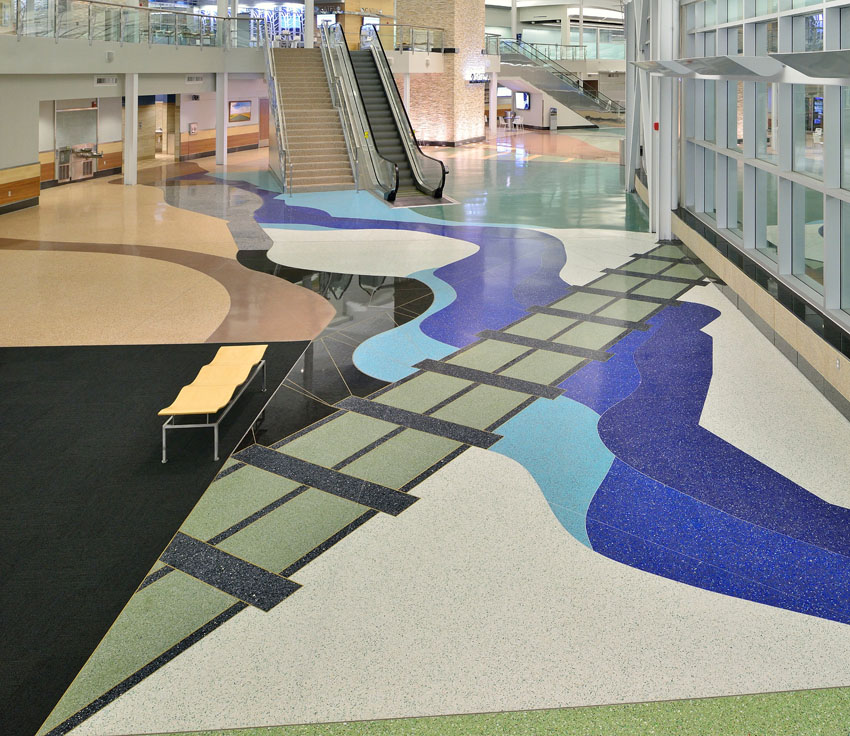Resilient and Sustainable Terrazzo Flooring
Common Misconceptions
Despite terrazzo’s long and distinguished history in architecture, and its increasing inclusion on projects today, many members of the design community still have several misconceptions about this material. Let’s take a look at some of the largest misunderstandings and set the record straight.
Installation Time
One of the biggest misconceptions in the market is that terrazzo flooring requires an incredible amount of time for proper installation. While the exact amount of time that an installation will take is specific to the project and impacted by factors like the climate in which the flooring is being installed, there are general timeframes that may be helpful. Cement terrazzo takes longer than epoxy terrazzo to install and can require three to seven days to cure after it has been installed. Epoxy terrazzo will typically cure overnight. In some parts of the country, such as Miami, contractors may be able to install it in the morning and be grinding it by the afternoon.
Thickness and Weight
Cement terrazzo was the original type of terrazzo. Five-hundred years ago, when the Venetians tossed the remnants of statues into the cement mix, they were making cement terrazzo. Epoxy terrazzo was introduced about 50 years ago and now makes up about 85–90 percent of the market in the United States. Many of the misconceptions about terrazzo today are centered around features of the older cement terrazzo material. For example, sand cushion terrazzo is a specific type of cement terrazzo system that many consider to be the top-of-the-line cement terrazzo solution. The sand cushion system features a layer of terrazzo that is 3 inches thick. This has left many architects with the impression that a high-quality terrazzo flooring must be 3 inches thick, requiring a 3-inch deck in the building plans to accommodate. In truth, there are high-quality terrazzo solutions available that are much thinner.
Epoxy terrazzo systems can be poured as thin as three-eighths of an inch. These thinner installations offer the same durability and strength found in the older, thicker systems. These thinner systems are also much lighter. Where sand cushion flooring weighs approximately 25 pounds per square foot, epoxy terrazzo only weighs 4 pounds per square foot.
New Construction versus Retrofit
Another common misconception is that terrazzo flooring can only be installed in a new construction project, but terrazzo is well-suited for both new construction and retrofit applications. Terrazzo can be poured over concrete slabs and other surfaces, old or new, and can certainly be installed in a new or existing space.
Design Flexibility
With terrazzo, the color selection is limitless, both for the color of the matrix and the colors of the various aggregates included in the matrix. There is also an incredible amount of flexibility in the possible forms that terrazzo flooring can take. A terrazzo surface is not restricted to modular sizes like tile or other flooring finishes, giving it the ability to accommodate designs that range from simple to extraordinarily complex.
“I think many designers do not realize how much you can do with terrazzo,” says architect Edward Balkin, director of design at Coover-Clark and Associates. “Colorwise, you can do almost anything with it, and you can produce elaborate designs or patterns in the flooring that give a space a different perspective and create a distinct, fresh look.”
Edward Balkin knows a thing or two about terrazzo, because he has specified this material many times, including on a recently completed airport terminal at the Minot International Airport (MOT) in Minot, North Dakota.
In Closing
In 2015, almost 300 million square feet of terrazzo were installed in the United States. A recent study conducted by a national research firm predicts that terrazzo will be one of the fastest-growing construction systems over the next 10 years, with annual installations expected to top 400 million square feet by 2024.
The recent (and growing) emphasis on resilient design may explain some of the anticipated increase in use. Terrazzo has demonstrated its inherently resilient nature, which can be attractive to architects and owners looking to create spaces equipped to handle extreme weather and disastrous conditions. Terrazzo has proven over time that it is difficult to damage and easy to repair. It ages well and can weather storms, making it one of few materials offering this blend of qualities.
Perhaps part of the reason for its increasing popularity is the market’s shift in thinking about sustainability and the increasing importance of the materials included in the built environment. Terrazzo is a textbook sustainability-friendly product. It has limited construction waste, can be regionally sourced, and will survive for the life of the building with minimal maintenance. This material is also good for the people around it. It is not cleaned with anything noxious. It will not harbor mold, mildew, or bacteria. As an added benefit, its design potential in terms of form and color is basically unlimited.
In short, terrazzo is good for the environment, good for the people who use it, good for the businesses built upon it, and good for the designers who want to create functional, beautiful, and unique spaces. It is the basic promise of the sustainability movement poured-in-place on the floor.
RESOURCES
Many of the projects profiled throughout this article were first published as case studies in Stories in Stone, a publication of the National Terrazzo & Mosaic Association. For more information, visit www.ntma.com/stories-in-stone.
Jeanette Fitzgerald Pitts has written nearly 100 continuing education courses exploring the benefits of incorporating new building products, systems, and processes into project design and development.










